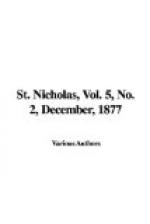“But how many kinds are there, uncle?” asked Will.
“That question demands an answer that must teach something,” said Uncle Jack. “There are two general kinds.”
“Why, I saw a thousand kinds at the Centennial,” interrupted Al, with a wise look.
[Illustration: CHINESE DOG (ROYAL WORCESTER PORCELAIN)]
“That may be,” said his uncle. “But then, too, you saw a thousand kinds of people, and yet all those people were either men or women; so all pottery comes under the two general classes of ‘hard paste’ and ’soft paste.’”
“Why, none of it was soft, Uncle Jack, was it? I thought it was all baked hard,” said Will, looking incredulous.
[Illustration: TEA-STAND (ROYAL WORCESTER PORCELAIN)]
“So all pottery is baked hard, for, until it is made hard by firing, it is only wet clay and sand,—in pretty shapes, perhaps, but not fit for any use or ornament,—and is not yet pottery.”
“Then why is it called ‘soft?’”
“You’ve seen pieces of stone that you could grind to powder under your heel? You’d call them ‘soft.’ Other pieces you couldn’t crush, and you’d call them ‘hard.’ That is something like what is meant by ‘hard’ and ‘soft’ applied to pottery,—at least, ‘soft’ doesn’t mean soft like putty.”
“But if it’s all baked, why isn’t it all hard alike?” asked Will.
“Because different clays are used, and different degrees of heat applied. At one time we get a kind of pottery that can be scratched with a knife, at another a ware too hard to be so scratched; the one is called ‘soft paste’ and the other ‘hard paste.’”
The boys seemed to be satisfied with this explanation.
“Uncle, didn’t you see at the Centennial some funny little figures representing all sorts of London street-people?” asked Will.
“Yes, and I brought one with me, I think. Ah! here’s one,” he said, showing them a droll little man about four inches high, “and it looks very like a London cabman—or ‘cabby,’ as he is called.”
“He’s very homely,” said Matie. “Where was he made, Uncle Jack?”
Her uncle turned the figure over, and, looking at a small round impression on the under side, answered: “At the Royal Worcester Works in England, where some of the best of modern porcelain has been made.”
“Is that hard paste or soft, Uncle Jack?” asked Willie, while Al, as if inclined to test the matter, began a search in his pockets for a knife.
“This is hard paste porcelain; it is ’translucent,’—that is, it shows the light through,” and he held the little cabman before the lamp.
“Here’s another piece from the same factory,” continued he, selecting a second specimen from the cabinet. “This is a copy of the Chinese ‘conventional dog,’ made of blue ‘crackle-ware.’ You see, the glaze is cracked all over the surface,” he added.
“Who ever saw a blue dog?” cried Matie.




